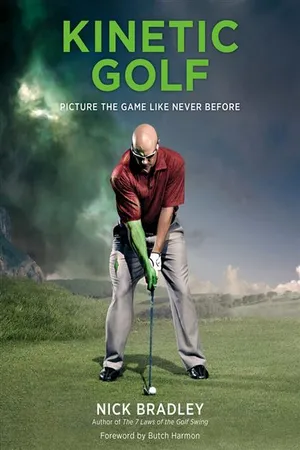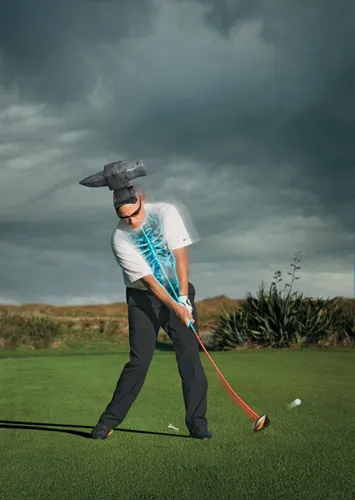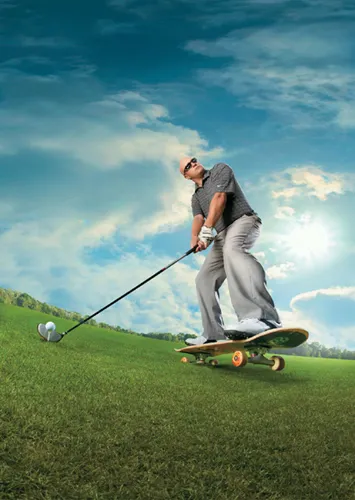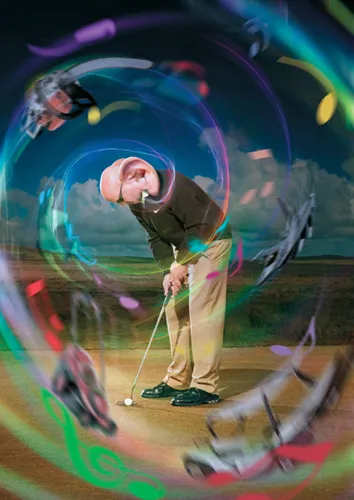![]()
THE BIG DRIVE I
The Big Drive I
HANG BACK AND FIRE!
There will be occasions when you receive that glowing green light to open your shoulders and hit it hard! To be able to tee the ball nice and high, dial in the launch angle with your spine, and then send it on one of those low-spin, high-launch bombers is a great asset. The key is to get behind the ball twice: once at address, and then at impact. This is when you hang back and fire!
Take a good look at the image. Anytime you get the spine moving away from the target like this, you create huge potential for a powerful ascending blow. Notice I used the word ascending. Since the spine is moving back, the low point of the swing (where the left arm and shaft reach their maximum radius) will be slightly behind the ball. Therefore, this feeling of hanging back is totally acceptable when you want to throw caution to the wind and bomb it out there!
So the key is to take your time with your backswing, to gather, store, and fully wind against a stable lower body. Look at the image here: When you sense the clubhead is near delivery, give your spine a nudge in the direction opposite to the target. Look at the way the shaft and the spine match. This shows that the shaft has been fully released into the back of the ball, thus squaring up the clubface. You see, you can hit a golf ball at 100 mph with a feather and it won’t go very far; you can hit the same golf ball at 100 mph with a brick and it will go a mile! So having that mass from which to release the shaft is the vital ingredient to a big hit.
In my years of coaching I have never seen a long driver of the ball who is not behind the ball at the time of impact. The trick to hanging back and firing is in the way the technique creates more leverage for you and, thus, more applied power. Unlike other swing moves, we can actually get the shaft to load twice in the downswing. “Loading the shaft” may be a new concept to you, so I’ll explain. Loading the shaft is merely what happens when great force is applied from the handle of the club through to the shaft, and then ultimately into the clubhead. The same loading (bend) can be seen with a fly fishing rod in the change of direction during the cast. With the “hang back and fire” technique you can load the shaft twice: once as you nudge a little backward in the downswing, and then again at impact into the ball.
Wait for that green light, and then give that ball some serious launch!
THE BIG DRIVE II
The Big Drive II
FACE IT: NO SHORT, POKEY SWING HITS IT ANYWHERE
To me, this image conjures up so many great things about long, straight driving. Essentially, though, it gives you a great prompt for when to stop the backswing and start the downswing of that intentional big hit.
The only guys who hit the ball vast distances with short swings are those who are blessed with fast-twitch muscle fiber. You know those guys—they seem to move at the speed of light. Bruce Lee comes to mind, with his famous one-inch punch! But more on that later …
Those of us who have a more ordinary blend of average mass and average muscle twitch need to maximize them and have physics on our side. We need to make sure that the clubhead has enough airspace in which to create momentum and, ultimately, speed. Even the ThrustSSC, the fastest car on Earth, needs a one-mile track to get up to 760 mph! This is verified! And you are demanding that the club-head swing at 100 mph through about twelve feet in just over a second! Well, the good news is that it can be done—if you give yourself the time to do it.
Another great feature of this image that you can use on the course is that there appears to be enough time to catch my reflection in the clubhead; there is obviously enough time for a classy change of direction. Nothing can kill the potential for power like a snatched and tension-dominated swing. It destroys any possibility of leverage and lag on the way down. With any of the great players I have observed over the years, the long hitters have always had that one-and-two rhythm to their swing. Therefore, my image really assists in giving you that settling sensation during the transition between backswing and downswing.
So when the time comes for you to unleash a drive with that little more to it, work from this image. It will give you the time to coil your body, give the clubhead the arc to travel and accelerate within, and promote a smooth but strong change of direction. Jack Nicklaus, probably the longest and straightest professional golfer in the modern era, had one thought that served him well throughout his career: “Complete the backswing.”
Thanks, Jack.
THE HIGH SHOT
The High Shot
SHRINK FOR LOFTY GOALS
There are times when it can be really advantageous to pop the ball a little higher than normal from the tee box. I’m primarily thinking of downwind drives (riding the wind) or shots into par threes where you want to get the ball just behind a guarded front-placed pin. So much of golf is how you dial in what you want at the address position; the rest is how well you get back there or re-create it at impact. For this high tee shot, we essentially guarantee the loft on the club through impact for as long as possible and promote a slightly shallower angle of attack.
As funny as the image looks, it really does convey your setup geometry in attempting to hoist the ball up a little higher. Look at how my right side looks smaller and lower in comparison to my left. Also, the handle of the club will be leaning a little away from the target; this subtle adjustment in the setup presets the feeling of loft through the ball and is a feeling you ultimately need to have in playing a high shot.
Obvious sensations will happen when you fit yourself into this image. Your weight will be a little more right-sided; as you look at the target, it will seem that your eyes swivel underneath it, looking from a low position to a high one. The clubface will be set back a little, providing loft, and there will be an added sense of cup in the left wrist because of that adjustment.
This shot also has the classic “use your eyes and pick your target” aspect to it. The skateboard you see under my feet gives you a great start in visualizing this shot. Hindsight is a great thing in golf, but “flightsight” is better! So really run your eyes up and down your intended trajectory and then ultimately lock in to the apex (the highest point) of the ball flight. If you can hold that apex (almost in the mind’s third eye) as you swing, you will unconsciously gravitate to hitting the ball at that spot on the higher wind thermal.
THE LOW SHOT
The Low Shot
DIVING PLANES: PLANELY BODY LANGUAGE
When I look at this image of the low shot, I always think about the kids I have taught and how they instinctively conjure the right positions for the shot ahead. Sometimes the power of description and suggestion is enough for the body. That, in essence, is what this book is all about—visual autosuggestion. The text in this case is merely support for the image; it is not the instruction in itself. I also think of great players like Seve Ballesteros. He got his body to fit the shot. So did Jack Nicklaus and Tiger Woods—golfing chameleons, if you will!
To play great shots, you definitely need to ask great questions: “What do I need to feel to get the ball to act this way? What does the clubface need to do? Where would my body need to be positioned to create that flight? What would my speed feel like?” Fortunately, kids don’t intellectualize these questions in this way; they speed-dial in to an image-feel directory and then organize themselves accordingly. As adults, we don’t lose this ability; it just gets masked by words, or sometimes we simply cannot be bothered to go through the act of obtaining the feel ourselves.
There are two main references you want to take from this image, and one overall feel. If you want the ball to go low, guess what? You have to feel low, especially in the follow-through. So observe how my chest and, indeed, my spine angle through the shot are lower to the ground than they would ordinarily be. This helps us trap or cover the ball. And observe the exit angle of the shaft; it is also low as it mirrors the low, chasing angle of the body. The overall feeling I would give you for this low shot would be similar to skimming a stone low on the water’s surface, crouching down, and staying still as the arm extends low down the line.
This image offers a pretty good incentive for staying low and quiet through this particular shot. Lee Trevino’s swing comes to mind—he was a master of controlling his ball trajectory through wind, with that low impact and finish of his. So the next time you want to hit a lower-flighted ball, make some smooth swings imitating and feeling how you would do it if a child had asked you to show him or her. I bet you wouldn’t look too far removed from my plane image on the opposite page!
OCCUPYING THE MIND
Occupying the Mind
MORE WILL BE LESS
I would wager much gold that when you have played your worst golf, your mind has been very, very busy! When the mind is busy with words flowing around your brain, playing good golf is almost impossible. Why is this? During this state of verbal onslaught, you are consciously aware of a great many things, such as noise, visual distractions, and of course your old buddy the ego chattering away in the background! We have all been there, usually when no balance is found between too much golf and too little.
You also see this awareness distraction happening at Tour level. A player will be over a shot and quite legitimately will glance up and nod disapprovingly at a cameraman or fan in the crowd. I say “legitimately” because there are times when the mind is waiting for that little something to react to, something that normally wouldn’t even register on the radar. I like to think of this as the black dot on the white page: Your mind, ready for just one little thing, zeroes in on the smallest blemish. So how do we cultivate the right level of awareness or, even better still, tune out when there is the possibility of distraction?
The knack to this is the white page, not the black dot. The next time you are on your putting green, grab three balls and start to make your way around, putting from hole to hole. As you start putting, place your awareness, most notably your hearing, all around you—as though you are casually listening to everything rather than intently waiting for something. All of a sudden you will be able to hear that plane above, cars driving in and out of the club, people chattering, greenkeepers mowing, and birds tweeting! So no single thing acts as the black dot on the page or has the chance to dominate, since your awareness is too general and broad to pick out one particular distraction. I really want you to notice, too, how the chattering, the incessant gibbering, starts to subside and fade out as your personal radar focuses wide and external rather than narrow and internal. It’s amazing how quiet you become when you achieve this effect. A great analogy is being in a dark room with a flashlight. This is how your awareness can work; it can uncontrollably dart around and light up little objects, if only for a brief second, as it searches for the next point of interest or distraction. Or you can flick on the bulb above the whole room and take in everything to the point where no one thing steals the limelight.
Transfer this new awareness state to your wedge play, your medium- to long-iron play, and eventually to the golf course. Distractions will be a thing of the past, and you’ll have the ability to make loud noises on the golf course with your quiet mind. So starting with the putting green, use this image anytime you ...






